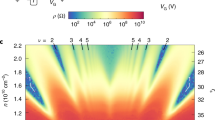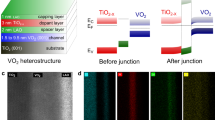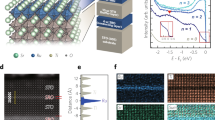Abstract
The explanation and control of phase transitions remain cornerstones of contemporary physics. Landau provided an invaluable insight into the thermodynamics of complex systems by formulating their phase transitions in terms of an order parameter. Within this formulation, continuous evolution of the order parameter away from zero classifies the phase transition as second-order, whereas a discontinuous change signals a first-order transition. Here we show that the temperature-tuned insulator–metal transition in the prototypical correlated electron system NdNiO3 defies this established binary classification. By harnessing a nanoscale optical probe of the local electronic conductivity, we reveal two physically distinct yet concurrent phase transitions in epitaxial NdNiO3 films. Whereas the sample bulk exhibits a first-order transition between metal and insulator phases, we resolve anomalous nanoscale domain walls in the insulating state that undergo a distinctly continuous insulator–metal transition, with hallmarks of second-order behaviour. We ascribe these domain walls to boundaries between antiferromagnetically ordered domains within the charge ordered bulk. The close correspondence of these observations to predictions from a Landau theory of coupled charge and magnetic orders highlights the importance of coupled order parameters in driving the complex phase transition in NdNiO3.
This is a preview of subscription content, access via your institution
Access options
Access Nature and 54 other Nature Portfolio journals
Get Nature+, our best-value online-access subscription
$29.99 / 30 days
cancel any time
Subscribe to this journal
Receive 12 print issues and online access
$209.00 per year
only $17.42 per issue
Buy this article
- Purchase on Springer Link
- Instant access to full article PDF
Prices may be subject to local taxes which are calculated during checkout




Similar content being viewed by others
References
Dagotto, E. Complexity in strongly correlated electronic systems. Science 309, 257–262 (2005).
Imada, M., Fujimori, A. & Tokura, Y. Metal–insulator transitions. Rev. Mod. Phys. 70, 1039–1263 (1998).
Medarde, M. L. Structural, magnetic and electronic properties of perovskites (R=rare earth). J. Phys. Condens. Matter 9, 1679–1707 (1997).
Catalan, G. Progress in perovskite nickelate research. Phase Transit. 81, 729–749 (2008).
Hepting, M. et al. Tunable charge and spin order in PrNiO3 thin films and superlattices. Phys. Rev. Lett. 113, 227206 (2014).
Boris, A. V. et al. Dimensionality control of electronic phase transitions in nickel-oxide superlattices. Science 332, 937–940 (2011).
Basov, D. N., Averitt, R. D. & Hsieh, D. Towards properties on demand in quantum materials. Nat. Mater. 16, 1077–1088 (2017).
Stewart, M. K., Liu, J., Kareev, M., Chakhalian, J. & Basov, D. N. Mott physics near the insulator-to-metal transition in NdNiO3. Phys. Rev. Lett. 107, 176401 (2011).
Park, H., Millis, A. J. & Marianetti, C. A. Site-selective Mott transition in rare-earth-element nickelates. Phys. Rev. Lett. 109, 156402 (2012).
Johnston, S., Mukherjee, A., Elfimov, I., Berciu, M. & Sawatzky, G. A. Charge disproportionation without charge transfer in the rare-earth-element nickelates as a possible mechanism for the metal–insulator transition. Phys. Rev. Lett. 112, 106404 (2014).
Mandal, B. et al. The driving force for charge ordering in rare earth nickelates. Preprint at https://arXiv1701.06819 (2017).
Lee, S., Chen, R. & Balents, L. Landau theory of charge and spin ordering in the nickelates. Phys. Rev. Lett. 106, 016405 (2011).
Dhaka, R. S. et al. Tuning the metal–insulator transition in NdNiO3 heterostructures via Fermi surface instability and spin fluctuations. Phys. Rev. B 92, 035127 (2015).
Ruppen, J. et al. Optical spectroscopy and the nature of the insulating state of rare-earth nickelates. Phys. Rev. B 92, 155145 (2015).
McLeod, A. S. et al. Nanotextured phase coexistence in the correlated insulator V2O3. Nat. Phys. 13, 80–86 (2017).
Qazilbash, M. M. et al. Mott transition in VO2 revealed by infrared spectroscopy and nano-imaging. Science 318, 1750–1753 (2007).
Liu, M. K. et al. Anisotropic electronic state via spontaneous phase separation in strained vanadium dioxide films. Phys. Rev. Lett. 111, 096602 (2013).
Liu, M. et al. Symmetry breaking and geometric confinement in VO2: Results from a three-dimensional infrared nano-imaging. Appl. Phys. Lett. 104, 121905 (2014).
Atkin, J. M., Berweger, S., Jones, A. C. & Raschke, M. B. Nano-optical imaging and spectroscopy of order, phases, and domains in complex solids. Adv. Phys. 61, 745–842 (2012).
Liu, S. et al. Random field driven spatial complexity at the Mott transition in VO2. Phys. Rev. Lett. 116, 036401 (2016).
Phillabaum, B., Carlson, E. W. & Dahmen, K. A. Spatial complexity due to bulk electronic nematicity in a superconducting underdoped cuprate. Nat. Commun. 3, 915 (2012).
Aharony, A. & Stauffer, D. Introduction to Percolation Theory (Taylor & Francis, Abingdon, 2003).
Perković, O., Dahmen, K. & Sethna, J. P. Avalanches, Barkhausen noise, and plain old criticality. Phys. Rev. Lett. 75, 4528–4531 (1995).
Mattoni, G. et al. Striped nanoscale phase separation at the metal–insulator transition of heteroepitaxial nickelates. Nat. Commun. 7, 13141 (2016).
Sanati, M. & Saxena, A. Landau theory of domain walls for one-dimensional asymmetric potentials. Am. J. Phys. 71, 1005–1012 (2003).
Parks, R. D. Superconductivity: Part 1 (CRC, Boca Raton, 1969).
Torrance, J. B., Lacorre, P., Nazzal, A. I., Ansaldo, E. J. & Niedermayer, C. Systematic study of insulator–metal transitions in perovskites RNiO3 (R = Pr,Nd,Sm,Eu) due to closing of charge-transfer gap. Phys. Rev. B 45, 8209–8212 (1992).
Daraktchiev, M., Catalan, G. & Scott, J. F. Landau theory of domain wall magnetoelectricity. Phys. Rev. B 81, 224118 (2010).
Lee, S., Chen, R. & Balents, L. Metal-insulator transition in a two-band model for the perovskite nickelates. Phys. Rev. B 84, 165119 (2011).
Zachar, O., Kivelson, S. A. & Emery, V. J. Landau theory of stripe phases in cuprates and nickelates. Phys. Rev. B 57, 1422–1426 (1998).
Papanicolaou, N. Antiferromagnetic domain walls. Phys. Rev. B 51, 15062–15073 (1995).
Scagnoli, V. et al. Role of magnetic and orbital ordering at the metal-insulator transition in NdNiO3. Phys. Rev. B 73, 100409(R) (2006).
Scagnoli, V. et al. Induced noncollinear magnetic order of Nd3+ in NdNiO3 observed by resonant soft x-ray diffraction. Phys. Rev. B 77, 115138 (2008).
McLeod, A. S. et al. Model for quantitative tip-enhanced spectroscopy and the extraction of nanoscale-resolved optical constants. Phys. Rev. B 90, 085136 (2014).
Caviglia, A. D. et al. Electric field control of the LaAlO3/SrTiO3 interface ground state. Nature 456, 624–627 (2008).
Ohtomo, A. & Hwang, H. Y. A high-mobility electron gas at the LaAlO3/SrTiO3 heterointerface. Nature 427, 423–426 (2004).
Reyren, N. et al. Superconducting interfaces between insulating oxides. Science 317, 1196–1199 (2007).
Valencia, S. et al. Interface-induced room-temperature multiferroicity in BaTiO3. Nat. Mater. 10, 753–758 (2011).
Ma, E. Y. et al. Mobile metallic domain walls in an all-in-all-out magnetic insulator. Science 350, 538–541 (2015).
Frenken, J. W. & Van der Veen, J. F. Observation of surface melting. Phys. Rev. Lett. 54, 134–136 (1985).
Lipowsky, R. Critical surface phenomena at first-order bulk transitions. Phys. Rev. Lett. 49, 1575–1578 (1982).
Dagotto, E. in Nanoscale Phase Separation and Colossal Magnetoresistance: The Physics of Manganites and Related Compounds Ch. 17 (Springer, Berlin Heidelberg, 2013).
Nolting, F. et al. Direct observation of the alignment of ferromagnetic spins by antiferromagnetic spins. Nature 405, 767–769 (2000).
Doran, A. et al. Cryogenic PEEM at the Advanced Light Source. J. Electron Spectrosc. Relat. Phenom. 185, 340–346 (2012).
Scholl, A. et al. Observation of antiferromagnetic domains in epitaxial thin films. Science 287, 1014–1016 (2000).
Wu, M. et al. Orbital reflectometry of PrNiO3/PrAlO3 superlattices. Phys. Rev. B 91, 195130 (2015).
Fei, Z. et al. Electronic and plasmonic phenomena at graphene grain boundaries. Nat. Nanotech. 8, 821–825 (2013).
Acknowledgements
This research was supported by ARO grant W911NF-17-1-0543. Development of cryogenic nano-optical instrumentation is supported by DE-SC0018218 and DE-SC-0012375. D.N.B. is in receipt of the Gordon and Betty Moore Foundation’s EPiQS Initiative investigator Grant GBMF4533. E.W.C. and Y.W. acknowledge support from NSF DMR-1508236 and Dept. of Education grant no. P116F140459. Financial support from the Deutsche Forschungsgemeinschaft (DFG) under Grant No. SFB/TRR80 G1 is acknowledged by M.H., M.B., G.C., G.L., P.R., M.M., E.B. and B.K.
Author information
Authors and Affiliations
Contributions
K.W.P., A.S.M and D.N.B. conceived of and conducted the nano-IR experiments, analysed the data, and composed the article. A.C., G.X.N. and A.P. assisted with nano-IR measurements. M.H., M.B., G.C., G.L., P.R., M.M., A.V.B., E.B. and B.K. grew the NdNiO3 film and conducted the XRD and transport measurements. Y.F.W., K.A.D. and E.W.C. performed theoretical studies to interpret domain morphology data in the context of Ising models and Landau theory.
Corresponding author
Additional information
Publisher’s note: Springer Nature remains neutral with regard to jurisdictional claims in published maps and institutional affiliations.
Supplementary information
Supplementary Information
Supplementary Information, Supplementary Figures S1–S16, Supplementary References 1–36
Rights and permissions
About this article
Cite this article
Post, K.W., McLeod, A.S., Hepting, M. et al. Coexisting first- and second-order electronic phase transitions in a correlated oxide. Nature Phys 14, 1056–1061 (2018). https://doi.org/10.1038/s41567-018-0201-1
Received:
Accepted:
Published:
Issue Date:
DOI: https://doi.org/10.1038/s41567-018-0201-1
This article is cited by
-
Infrared nano-imaging of Dirac magnetoexcitons in graphene
Nature Nanotechnology (2023)
-
Probing the evolution of electronic phase-coexistence in complex systems by terahertz radiation
Communications Materials (2022)
-
Quantifying the role of the lattice in metal–insulator phase transitions
Communications Physics (2022)
-
Ferroelectric phase-transition frustration near a tricritical composition point
Nature Communications (2021)
-
Designing and controlling the properties of transition metal oxide quantum materials
Nature Materials (2021)



